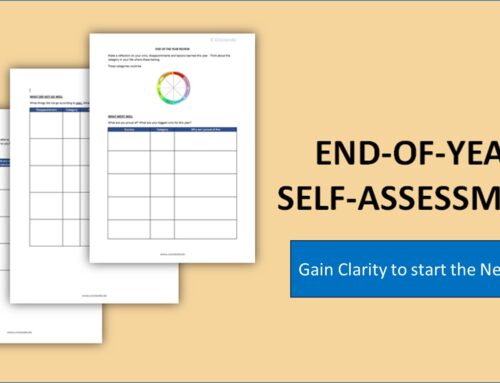Setting goals is easy. Achieving them? Not so much. Many of us start the year brimming with enthusiasm, only to watch our aspirations fade into the background as life gets busy. Have you ever been there? I know I have!
In my quest to understand why I was not achieving what I wanted I realized there were some common denominators in all my failed attempts:
- Overwhelm from Complexity: Tackling too many goals at once made life chaotic, and it was difficult to prioritize.
- Assuming a Best-Case Scenario: Life is unpredictable, yet I was planning as if everything would go perfectly.
- Lack of Follow-Through: I was setting goals without a system to track progress.
I noticed that the same thing happened to my coaching clients. For example, Sarah, a project manager, started the year with seven goals, ranging from “improving team collaboration” to “getting in better shape.” By March, she realized she hadn’t made significant progress on any of them because she had spread herself too thin. Sound familiar?
I realized I needed to take a different approach, and if successful I will suggest it to my clients as well.
After reading countless books about goal setting, and techniques to make goals SMART, I found out about the 3×3 goal achievement strategy.
The 3×3 Goal Achievement Strategy revolves around three levels of focus: quarterly, weekly, and daily. By narrowing your attention, you eliminate the overwhelm and chaos often associated with goal setting.
Quarterly Big 3: The Power of Focus
Instead of juggling a dozen goals, identify three main priorities for the next three months. Quarterly focus allows you to work deeply on significant objectives while maintaining flexibility to adapt as life evolves.
How to Choose Your Quarterly Big 3:
- What’s Most Important? Identify the goals that will have the greatest impact on your career or personal life.
- What’s Urgent? Assess deadlines or time-sensitive opportunities.
- What’s Feasible? Consider your capacity and avoid overloading yourself.
For example:
- One of my clients, a marketing professional is focusing this year on launching a new campaign, completing a certification, and mentoring a junior colleague.
- Another client, a leader is prioritizing improving team communication, streamlining workflows, and enhancing his leadership skills.
Tip: Keep your goals visible—write them on a sticky note, pin them to your workspace, or add them to your digital planner.
Weekly Big 3: Keeping the Momentum
Once you’ve identified your quarterly goals, break them into weekly milestones. These smaller tasks should directly contribute to your bigger objectives.
Why Weekly Focus Works:
- It helps you evaluate progress regularly.
- It prevents procrastination by setting shorter deadlines.
- It allows you to pivot if needed.
How to Define Your Weekly Big 3:
- Start with a weekly review: Look at your quarterly goals and ask, What can I realistically achieve this week to move closer to my objectives?
- Use the Eisenhower Matrix: Prioritize tasks that are important and urgent while avoiding busy work.
For instance:
Alex, a newly appointed team lead, is setting three weekly goals to improve collaboration: scheduling one-on-one check-ins with team members, identifying bottlenecks in processes, and drafting a plan to address them. By breaking down his quarterly goal, he makes consistent progress without feeling overwhelmed.
Pro Tip: Schedule your weekly planning session on Sunday evenings or Monday mornings. It sets the tone for a productive week.
Daily Big 3: Small Wins, Big Results
At the daily level, identify three non-negotiable tasks that you commit to completing. This laser-focused approach ensures that each day feels productive, no matter what chaos unfolds.
Why the Daily Big 3 Works:
- It builds momentum through consistent progress.
- It gives you a sense of accomplishment, reducing stress and boosting motivation.
- It forces you to prioritize instead of multitasking.
How to Choose Your Daily Big 3:
- Focus on tasks that align with your weekly goals.
- Use the Pareto Principle: Identify the 20% of tasks that will drive 80% of your results.
- Be realistic: Overloading your to-do list sets you up for failure.
Tools to Help You Stay on Track
Success with the 3×3 strategy often comes down to using the right tools. Here are some recommendations:
- Digital Planners: Use tools like Trello, Asana, or Notion to organize your goals visually.
- Daily Journals: Write down your Daily Big 3 each morning to start the day with intention.
- Habit Trackers: Apps like Habitica or Streaks can help you stay accountable and motivated.
To keep yourself accountable, ask yourself at the end of each week: What worked? What didn’t? What can I improve for next week? This reflection ensures you’re continuously refining your approach.
You will notice that the 3×3 strategy is rooted in simplicity, focus, and consistent action. By narrowing your attention to three priorities at each level, you eliminate decision fatigue, reduce overwhelm, and build momentum.
Your Turn: apply the 3×3 goal achievement strategy in your life
As the new year unfolds, it’s time to rethink how you approach your goals. The 3×3 Goal Achievement Strategy offers a roadmap to turn your aspirations into achievements—without the overwhelm.
Action Steps:
- Write down your Quarterly Big 3 today.
- Break them into Weekly Big 3 milestones.
- Start each morning by committing to your Daily Big 3.
By the end of the year, you’ll look back with pride at what you’ve accomplished.
What are your top three goals for the year? Share them in the comments below—I’d love to cheer you on!





Leave A Comment